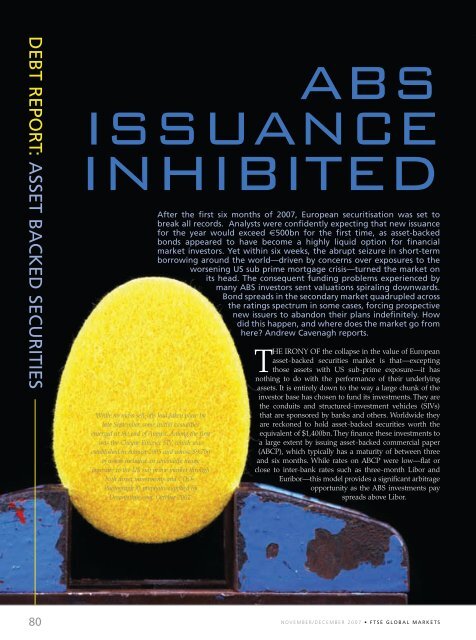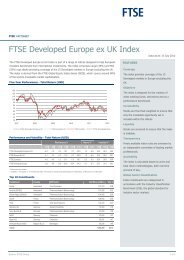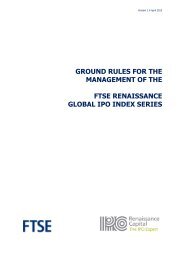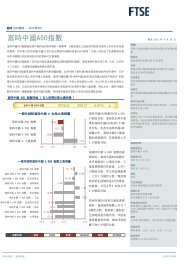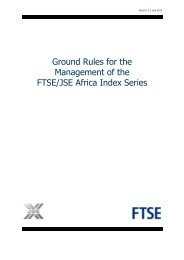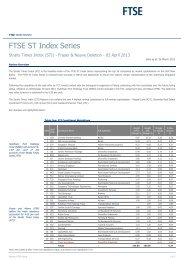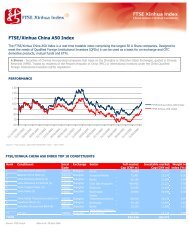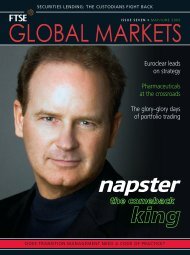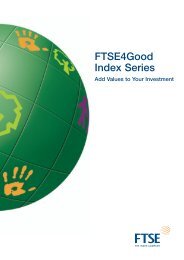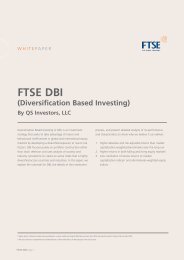Section 2 - FTSE
Section 2 - FTSE
Section 2 - FTSE
You also want an ePaper? Increase the reach of your titles
YUMPU automatically turns print PDFs into web optimized ePapers that Google loves.
DEBT REPORT: ASSET BACKED SECURITIES<br />
80<br />
ABS<br />
ISSUANCE<br />
INHIBITED<br />
While no mass sell-offs had taken place by<br />
late September, some initial casualties<br />
emerged at the end of August. Among the first<br />
was the Cheyne Finance SIV, which was<br />
established in August 2005 and whose $9.7bn<br />
of assets included an unusually heavy<br />
exposure to the US sub prime market through<br />
both direct investments and CDOs.<br />
Photograph © pmphoto, supplied by<br />
Dreamstime.com, October 2007.<br />
After the first six months of 2007, European securitisation was set to<br />
break all records. Analysts were confidently expecting that new issuance<br />
for the year would exceed €500bn for the first time, as asset-backed<br />
bonds appeared to have become a highly liquid option for financial<br />
market investors. Yet within six weeks, the abrupt seizure in short-term<br />
borrowing around the world—driven by concerns over exposures to the<br />
worsening US sub prime mortgage crisis—turned the market on<br />
its head. The consequent funding problems experienced by<br />
many ABS investors sent valuations spiraling downwards.<br />
Bond spreads in the secondary market quadrupled across<br />
the ratings spectrum in some cases, forcing prospective<br />
new issuers to abandon their plans indefinitely. How<br />
did this happen, and where does the market go from<br />
here? Andrew Cavenagh reports.<br />
THE IRONY OF the collapse in the value of European<br />
asset-backed securities market is that—excepting<br />
those assets with US sub-prime exposure—it has<br />
nothing to do with the performance of their underlying<br />
assets. It is entirely down to the way a large chunk of the<br />
investor base has chosen to fund its investments. They are<br />
the conduits and structured-investment vehicles (SIVs)<br />
that are sponsored by banks and others. Worldwide they<br />
are reckoned to hold asset-backed securities worth the<br />
equivalent of $1,400bn. They finance these investments to<br />
a large extent by issuing asset-backed commercial paper<br />
(ABCP), which typically has a maturity of between three<br />
and six months. While rates on ABCP were low—flat or<br />
close to inter-bank rates such as three-month Libor and<br />
Euribor—this model provides a significant arbitrage<br />
opportunity as the ABS investments pay<br />
spreads above Libor.<br />
NOVEMBER/DECEMBER 2007 • <strong>FTSE</strong> GLOBAL MARKETS


